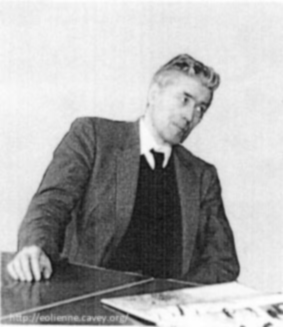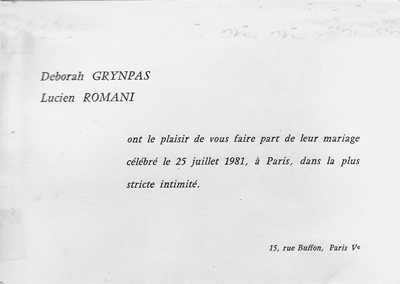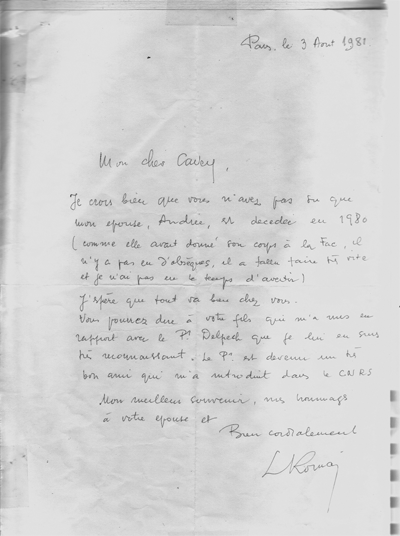Lucien Romani |
Brief biography :
The only biography of Lucien Romani that I know of is a curriculum written by himself and which he describes as "subjective". It is dated 6 December 1983. This "Subjective Curriculum" was published by the Association pour la Création et la Diffusion Scientifique in december 1991
We learn that Lucien Francis Nicolas Romani, born on 19 November 1909 in Paris 20th district, was sent by his parents to the countryside during the First World War. It was at the village school that he passed his primary school certificate, the only diploma he ever obtained. Thereafter, he says, he studied haphazardly and only what interested him. His favourite books were those in the library of his older brother Gaston Romani, an amateur astronomer; "Astronomie Populaire" and "Cyrano de Bergerac".
Between the two wars, he earned his living as an architect's clerk. A good amateur chess player, he was the main contributor to a specialized monthly magazine.
One day he wrote to the astronomer Henri Mineur to submit a project for a "star counter on a cliché" which, writes Lucien Romani, seduced Mineur. On his recommendation, Professor Joseph Péres hired him at the Laboratoire d'Analogies Electriques at the Sorbonne. He worked clandestinely throughout the war in the basement of the Ecole Normale Supérieure under the authority of mathematician Henri Villat.
"Lacking diplomas and rebelling against any hierarchy", he decided to create his own design office in 1946 and entrusted its administrative management to his elder brother Gaston Romani (1895-17 février 1967). The Bureau d'Etudes Scientifiques et Techniques (BEST) had its headquarters on rue Léonidas in the 14th arrondissement of Paris. BEST, which had up to forty employees, was self-financing for twenty years.
In 1966, the shutdown of the Nogent-le-Roi wind turbine, the failure of the two-rotor wind turbine project, and the death of his brother Gaston in 1967, led BEST to liquidation.
Lucien Romani was then appointed Technical Director at the Soufflerie Eiffel, rue Boileau, in Paris 16ieme (Aérodynamique Expérimentale).
He ended his life on 17 February 1990 in the 5th arrondissement of Paris (Source: Files of deceased persons established by INSEE from information received from the communes as part of their public service mission).
The work of Lucien Romani:
Lucien Romani was particularly prolific and eclectic. Lucien Romani was particularly prolific and eclectic. We owe him somewhat iconoclastic writings in a wide variety of fields. As he writes himself, he is "cyclothymic" and has hardly any discipline. "I switch at any time, at my whim, from Physics to Biology, from Biology to Astronomy [...]. In any field, I have only one goal: to reach the truth. Never mind if it displeases, never mind if it shocks, never mind if it displeases. [...]. I do not attach the slightest importance to the consensus of the mandarins and their students, nor the argument of authority.
With such a character, it is understandable that Lucien Romani was able to launch into writings as diverse as an "attempt to renovate theoretical physics" (only that!) or a "General Theory of Evolution" in which he swept aside Neo-Darwinism without paying the slightest attention to the concrete and tangible results of fundamental genetics. Realizing that the Cartesian method was not enough, he developed two others: one, which he called "amalgam", was anti-Cartesian (it grouped two more or less related problems to solve them at once); the other, called "parallel analysis", was neutral and promoted reasoning by analogy.
This 'failed autodidact', as he calls himself, could have been just an enlightened Professor Nimbus. It turns out - and curiously, he does not mention this in his autobiography - that he had a perfect command of aerodynamics and, more generally, of everything to do with wind. The ACDS, in the document that it published on the Scientific Work of Lucien Romani, counts about fifty patents registered by Lucien Romani, between May 23, 1947 (" Hypersuspension device for a wing with a strong backward deflection ", patent 1.000.856) and April 4, 1978 (" Improvement to energy generators ", patent 1.422.226). All these patents concern the dynamics of gaseous fluids and - of course - wind energy (his second patent, filed on 20 January 1948, already concerns the "Improvement to wind turbines", No. 1.006.473).
However, Lucien Romani would probably have fallen into oblivion if it had not been for the wind turbine of Nogent-le-Roi which allowed him to show - and in what manner - the measure of his theoretical genius and technical know-how.
Lucien Romani and the Cavey:
Although my father was, in the end, only an employee of BEST from 1 January 1955 to 30 April 1960, he remained in contact with Lucien Romani until he died in 1990.
I was 8 years old in 1955 and 13 in 1960. I remember the visits we made to him and his wife, the adorable and patient Andrée Romani, in Verrières-le-Buisson where I drank his words like milk.
I saw him again later when he and his wife visited my parents in the Loir-et-Cher. Time had passed and I had become an INA agricultural engineer. Our discussions on his theories of evolution were even more lively and just as fascinating.
L. Romani remarriage announcement
Lucien Romani had adopted the theories of William H. Sheldon (Somatotype Theory, in « Varieties of Human Physique », Harper & Brothers, 1940), then Melvin Page, Henry Bieler and Elliot Abravanel, (Glandular Types Theory), according to whom the psychomorphology of individuals is controlled by their hormonal balance (glandular types theory). According to these theories, which - from the biologist's point of view - are not absurd, the hypothesis is that there is a link between certain physical traits (general appearance, shape of the face, shape of the hands) and psychological behaviour, the link being the dominant hormone or hormones. There would thus be a thyroid, adrenal, pituitary typology, etc... Although I was never passionate about this theory, I had the opportunity to put him indirectly in contact with Professor Delpech who taught this theory at the Sorbonne. Thus, on August 3, 1981, in a handwritten letter, in which he informed my father of the death, the previous year, of his wife Andrée and his remarriage, Lucien Romani noted: « You can tell your son who put me in touch with Prof. Delpech that I am very grateful to him. Professor Delpech became a very good friend who introduced me to the CNRS ».
Autograph letter from Lucien Romani in 1981.
Some publications by or about Lucien Romani found on the Internet :
- Lucien Romani sur Wikipedia (France) and Geobiology (pseudoscience) in Wikipedia (English)
- L'oeuvre scientifique de Lucien Romani, from the journal DIRE.
- Proposition pour la continuation des travaux by Lucien Romani
- Lucien Romani by Marc Deschamps
- La pensée animale et la nôtre by Lucien Romani
- Causeries au laboratoire Eiffel by Jean-Michel Cornu
- Lucien Romani et l'observatoire de Meudon by Audouin Dollfus
- Étude d’un cas d’alterscience : l’ingénieur Lucien Romani (1909-1990), by Alexandre Moatti, edited by Stéphane François, Un XXIe siècle irrationnel? Analyses pluridisciplinaires des pensées " alternatives ", Paris, CNRS éditions, 2018



